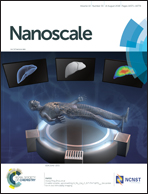Reduction of graphene oxide alters its cyto-compatibility towards primary and immortalized macrophages†
Abstract
Graphene oxide (GO) and its derivatives (e.g., reduced graphene oxide, RGO) have shown great promise in biomedicine. Although many studies have been conducted to understand the relative cyto-compatibility between GO and RGO materials, the results are inconclusive and controversial. In this study, we compared the biocompatibility aspects (e.g. cytotoxicity, pro-inflammatory effects and impairment of cellular morphology) between parental and reduced GOs towards macrophages using primary bone marrow-derived macrophages (BMDMs) and J774A.1 cell line. Two RGOs (RGO1 and RGO2) with differential reduction levels relative to the parental GO were prepared. Intriguingly, besides loss of oxygen-containing functional groups, significant morphological alteration of GO occurred, from the sheet-like structure to a polygonal curled shape for RGO, without significant aggregation in biological medium. Cytotoxicity assessment unveiled that the RGOs were more toxic than pristine GO to both types of cells. It was surprising to find for the first time (to our knowledge) that GO and RGOs elicited different effects on the morphological changes of BMDMs, as reflected by elongated protrusions from GO treatment and shortened protrusions from the RGOs. Furthermore, RGOs induced greater pro-inflammatory responses than GO, especially in BMDMs. Compromised cyto-compatibility of RGOs was attributable (at least partially) to their greater oxidative stress in macrophages. Mechanistically, these differences in bio-reactivities between GO and RGO should be boiled down to (at least in part) the synergistic effects from the variation of oxygen-containing functional groups and the distinct morphology in between. This study unearthed the crucial contribution of reduction-mediated detrimental cellular effects between GO and RGO towards macrophages.



 Please wait while we load your content...
Please wait while we load your content...